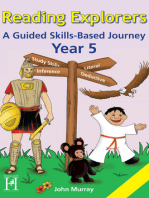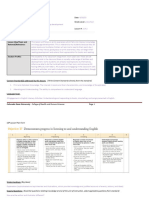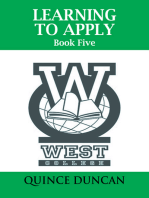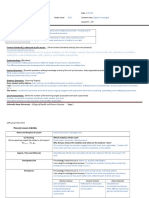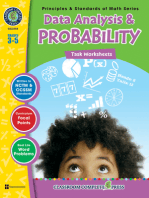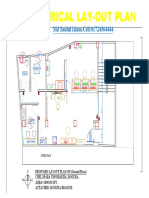CEP Lesson Plan Form: Colorado State University College of Health and Human Sciences Page 1
Uploaded by
api-279610141CEP Lesson Plan Form: Colorado State University College of Health and Human Sciences Page 1
Uploaded by
api-279610141CEP Lesson Plan Form
Teacher: Mitch McFall
School:
Choices
Town High
Date: 03/15/15
Grade Level: High School Content Area: Teen
Title: Drug Free Me! Lesson 5
Content Standard(s) addressed by this lesson:
directly from the standard)
FCCLA.02
Lesson # 5 of 6
(Write Content Standards
Applied Technology
FMCS.08.05.b
(Teen) Judge validity and reliability of information, sources,
opinions, and evidence.
Understandings: (Big Ideas)
I understand the differences between the various types of illicit substances, and
what each entails. I can take the presented evidence and make accurate
assumptions about the different drugs and the level of harm they cause to the
human body.
Inquiry Questions: (Essential questions relating knowledge at end of the unit of
instruction, select applicable questions from standard)
What are the different types of illicit substances?
What are their different effects, or desired traits, that people look for when doing
the drug?
What are the side effects of each individual substance, and what are the similarities
between the different types?
Evidence Outcomes: (Learning Targets/Objectives)
Every student will be able to: identify the different types of substances, and
their effects on the human body and its development.
I can: understand the differences between the various types of illicit
substances, and what each of their respected effects are, as well as the
reasoning behind why they are so harmful.
This means: I am able to apply the knowledge presented to me, and make
the proper choices as to why drugs are bad for you.
List of Assessments: (Write the number of the learning target associated with
each assessment)
Formal, and informal. The students will be graded on their ability to produce
an accurate, and aesthetically pleasing presentation. The informal will be more
WDYLs.
Colorado State University College of Health and Human Sciences
Page 1
CEP Lesson Plan Form
List of Significant Vocabulary: (List the significant vocabulary words and
definitions for this lesson)
Substance, side effect, harmful, addiction, etc.
Colorado State University College of Health and Human Sciences
Page 2
CEP Lesson Plan Form
Planned Lesson Activities
Name and Purpose of Lesson
Should be a creative title for you and the students
to associate with the activity. Think of the purpose
as the mini-rationale for what you are trying to
accomplish through this lesson.
Approx. Time and Materials/Procedures
How long do you expect the activity to last and
what materials will you need? What do you need
to collect, prepare, reserve, set-up, etc. ahead of
time?
Drug Free Me! Lesson 5. This lesson is designed to get students
informed on the different types of drugs and alcohol, and their
respective effects on the human body.
Pre-Assessment
How will you pre-assess students knowledge of
the topic to be covered? Describe both formal
and informal ways you will assess their knowledge
Anticipatory
Set/Focus/Hook/Engagement/Motivation/Intr
oduction
The hook grabs students attention and
engages them from the start. These are actions
and statements by the teacher to relate the
experiences of the students to the objectives of
the lesson and to put students into a receptive
frame of mind.
To focus student attention on the lesson.
To create an organizing framework for the
ideas, principles, or information that is to
follow (advanced organizers)
An anticipatory set is used any time a different
activity or new concept is to be introduced.
Procedures/Instructional Input/Learning
Chunks/Scaffolding for Learning (this is the
largest part of your lesson plan)
(Include a play-by-play account of what will
There will be no pre-assessment for this lesson, except maybe a
question time.
Students should be prepared to present their projects, and that
will be the first part of class.
This lesson will take the whole class, and the students will need
either the computer for power points, or the large paper if they
made posters. Each group will have roughly 10 minutes for their
presentation, and any less can be used for questions, and
Glows/Grows.
The anticipatory set will be time for the students to get their
presentations ready, and establish a presenting order.
The introduction will be the same.
The students will each take turns presenting their projects, and
if they accurately portray the information, and design the
project in a good way, they will get a good grade. If not, they
Colorado State University College of Health and Human Sciences
Page 3
CEP Lesson Plan Form
happen in the class from the minute students
arrive to the minute they leave your classroom.
Indicate the length of each segment of the lesson.
List actual minutes.)
Include the following components in scripted
format:
-Teacher input-what you will share (lecture
outline, notes of interest, facts, vocabulary,
description of activities, etc.)
-Modeling (demonstrations, stories, examples,
etc.)
-questioning strategies (what questions will you
ask to CSU)
-guided/unguided:
-whole-class practice
-group practice
-individual practice
-check for understanding
-other (FCCLA, FFA, etc. connection)
Closure/Conclusion/Summary/Adjustments/
Wrap-up/Clean-up
Those actions or statements by a teacher that are
designed to bring a lesson presentation to an
appropriate conclusion. Used to help students
bring things together in their own minds, to make
sense out of what has just been taught. Any
Questions? No. OK, lets move on is not closure.
Closure is used:
To cue students to the fact that they have
arrived at an important point in the lesson
or the end of a lesson.
To help organize student learning
To help form a coherent picture and to
consolidate.
Differentiation/Modifications/Adaptations/Ac
commodations To modify: If the activity is too
will suffer.
My input can be brought out if there is majorly inaccurate
information, and most questions will be saved for the end if
there is time.
The end will be used for questioning, as well as a quick WDYL.
The students will take notes on the substances as their
classmates present, and that can be used to study for the unit
test.
The end of class can be designated as exam study time, as well
as the beginning of the next class period.
The end of the class will be used for a WDYL, as well as unit
exam review time. The pre-assessment tests will be handed
back for the students to look over, but not to take home.
This time can also be used to answer any questions that
students have about the test.
Get copies of the projects from each group, for students to use
Colorado State University College of Health and Human Sciences
Page 4
CEP Lesson Plan Form
advanced for a child, how will you modify it so
that they can be successful?
To extend: If the activity is too easy for a child,
how will you extend it to develop their emerging
skills?
Assessment/Pre-Post/On-going
How will you know if students met the learning
targets? Review each learning target and
determine the assessment that met that target.
Can the students answer your inquiry questions?
Write a description of what you were looking for in
each assessment.
at their discretion, and if certain students need to move from
their seat, or need things repeated, arrangements can be
made.
The assessment will be if the accurately portrayed their
assigned substance, and if they covered all the required
subjects. They will also be graded on whether or not their
presentation was clear and concise, as well as aesthetically
pleasing.
Colorado State University College of Health and Human Sciences
Page 5
CEP Lesson Plan Form
Post Lesson Reflection
1. To what extent were lesson objectives achieved? (Utilize
assessment data to justify your level of achievement)
2. What changes, omissions, or additions to the lesson would
you make if you were to teach again?
3. What do you envision for the next lesson? (Continued practice,
reteach content, etc.)
Colorado State University College of Health and Human Sciences
Page 6
You might also like
- Six Steps to College Success: Learning Strategies for STEM StudentsFrom EverandSix Steps to College Success: Learning Strategies for STEM StudentsNo ratings yet
- Bostitch: Operation and Maintenance ManualNo ratings yetBostitch: Operation and Maintenance Manual28 pages
- The Study Skills Curriculum: Developing Organized Successful Students Elementary-High SchoolFrom EverandThe Study Skills Curriculum: Developing Organized Successful Students Elementary-High SchoolNo ratings yet
- FTCE Social Science 6-12 Skill Practice: Practice Test Questions for FTCE Social Science TestFrom EverandFTCE Social Science 6-12 Skill Practice: Practice Test Questions for FTCE Social Science TestNo ratings yet
- Discipline in the Secondary Classroom: A Positive Approach to Behavior ManagementFrom EverandDiscipline in the Secondary Classroom: A Positive Approach to Behavior ManagementNo ratings yet
- COOP Skill Practice: Practice Test Questions for the Cooperative Admissions Examination Program (COOP)From EverandCOOP Skill Practice: Practice Test Questions for the Cooperative Admissions Examination Program (COOP)No ratings yet
- CEP Lesson Plan Form: Colorado State University College of Health and Human Sciences Page 1No ratings yetCEP Lesson Plan Form: Colorado State University College of Health and Human Sciences Page 16 pages
- CEP Lesson Plan Form: Colorado State University College of Health and Human Sciences Page 1No ratings yetCEP Lesson Plan Form: Colorado State University College of Health and Human Sciences Page 16 pages
- CEP Lesson Plan Form: Colorado State University College of Health and Human Sciences Page 1No ratings yetCEP Lesson Plan Form: Colorado State University College of Health and Human Sciences Page 16 pages
- Blueprint For Thoughtful Lesson Planning: Excavating For Conceptual UnderstandingFrom EverandBlueprint For Thoughtful Lesson Planning: Excavating For Conceptual UnderstandingNo ratings yet
- Using Formative Assessment to Improve Student Outcomes in the ClassroomFrom EverandUsing Formative Assessment to Improve Student Outcomes in the ClassroomNo ratings yet
- Accelerated Learning Techniques: Unlimited Photographic Memory Mastery and Memory ImprovementFrom EverandAccelerated Learning Techniques: Unlimited Photographic Memory Mastery and Memory ImprovementNo ratings yet
- The Practical Guide to RTI: Six Steps to School-Wide Success: Six Steps to School-wide SuccessFrom EverandThe Practical Guide to RTI: Six Steps to School-Wide Success: Six Steps to School-wide SuccessNo ratings yet
- The Structured Method of Pedagogy: Effective Teaching in the Era of the New Mission for Public Education in the United StatesFrom EverandThe Structured Method of Pedagogy: Effective Teaching in the Era of the New Mission for Public Education in the United StatesNo ratings yet
- Passing Exams with Confidence Strategies for Study Habit ImprovementFrom EverandPassing Exams with Confidence Strategies for Study Habit Improvement5/5 (1)
- CST Students with Disabilities: New York State Teacher CertificationFrom EverandCST Students with Disabilities: New York State Teacher Certification5/5 (1)
- Story of The Exam: Know the Structure of Your Exam for Better Score!!From EverandStory of The Exam: Know the Structure of Your Exam for Better Score!!1/5 (2)
- Techniques for Learning Happily: Certain Games Lead You to Discover Your Skills in LearningFrom EverandTechniques for Learning Happily: Certain Games Lead You to Discover Your Skills in LearningNo ratings yet
- How to Practice Before Exams: A Comprehensive Guide to Mastering Study Techniques, Time Management, and Stress Relief for Exam SuccessFrom EverandHow to Practice Before Exams: A Comprehensive Guide to Mastering Study Techniques, Time Management, and Stress Relief for Exam SuccessNo ratings yet
- PERT Study Guide: Post Secondary Education Readiness Test Study Guide and Practice QuestionsFrom EverandPERT Study Guide: Post Secondary Education Readiness Test Study Guide and Practice QuestionsNo ratings yet
- Cep Lesson Plan 1 Great Depression 2 2 2018No ratings yetCep Lesson Plan 1 Great Depression 2 2 20187 pages
- Teacher: Date: School: Grade Level: Content Area: Title: Lesson #: ofNo ratings yetTeacher: Date: School: Grade Level: Content Area: Title: Lesson #: of6 pages
- Who Packed Your Parachute? Why Multiple Attempts on Assessments Matter: Quick Reads for Busy EducatorsFrom EverandWho Packed Your Parachute? Why Multiple Attempts on Assessments Matter: Quick Reads for Busy EducatorsNo ratings yet
- Canadian Firefighter Skill Practice: Canadian Firefighter Practice Test QuestionsFrom EverandCanadian Firefighter Skill Practice: Canadian Firefighter Practice Test QuestionsNo ratings yet
- Goals Decisions Worksheet: Mitch Mcfall Tws Section 6 Assessment Data and AnalysisNo ratings yetGoals Decisions Worksheet: Mitch Mcfall Tws Section 6 Assessment Data and Analysis2 pages
- CEP Lesson Plan Form: Colorado State University College of Health and Human Sciences Page 1No ratings yetCEP Lesson Plan Form: Colorado State University College of Health and Human Sciences Page 15 pages
- Health and Diets Webquest Activity Sheet Name: By: Mitch Mcfall DateNo ratings yetHealth and Diets Webquest Activity Sheet Name: By: Mitch Mcfall Date1 page
- TNSDC Recruitment 15 Senior Associate Project Associate Notification 1No ratings yetTNSDC Recruitment 15 Senior Associate Project Associate Notification 18 pages
- Bagumbayan-Vnp Movement, Inc. vs. ComelecNo ratings yetBagumbayan-Vnp Movement, Inc. vs. Comelec6 pages
- 1 Intro Rizal Family Background LWW Rizal 2021No ratings yet1 Intro Rizal Family Background LWW Rizal 202133 pages
- Video Essay Script For Hairspray Character Analysis ThingyNo ratings yetVideo Essay Script For Hairspray Character Analysis Thingy23 pages
- ABB COMBIFLEX Mounting and Engineering System For Relay and Control PanelsNo ratings yetABB COMBIFLEX Mounting and Engineering System For Relay and Control Panels10 pages
- A Study On SHG-Bank Linkage and Status of MFI in BiharNo ratings yetA Study On SHG-Bank Linkage and Status of MFI in Bihar196 pages
- Battery Builders Models: BBSS, Bbes: Installation and Operation ManualNo ratings yetBattery Builders Models: BBSS, Bbes: Installation and Operation Manual23 pages
- Transport and Logistics Module 1 (1) (1)No ratings yetTransport and Logistics Module 1 (1) (1)22 pages
- Electrical Chelopara Uposhakha, Bogura-Model PDFNo ratings yetElectrical Chelopara Uposhakha, Bogura-Model PDF1 page
- John Patterson BTP Launchpad Business SuiteNo ratings yetJohn Patterson BTP Launchpad Business Suite19 pages


